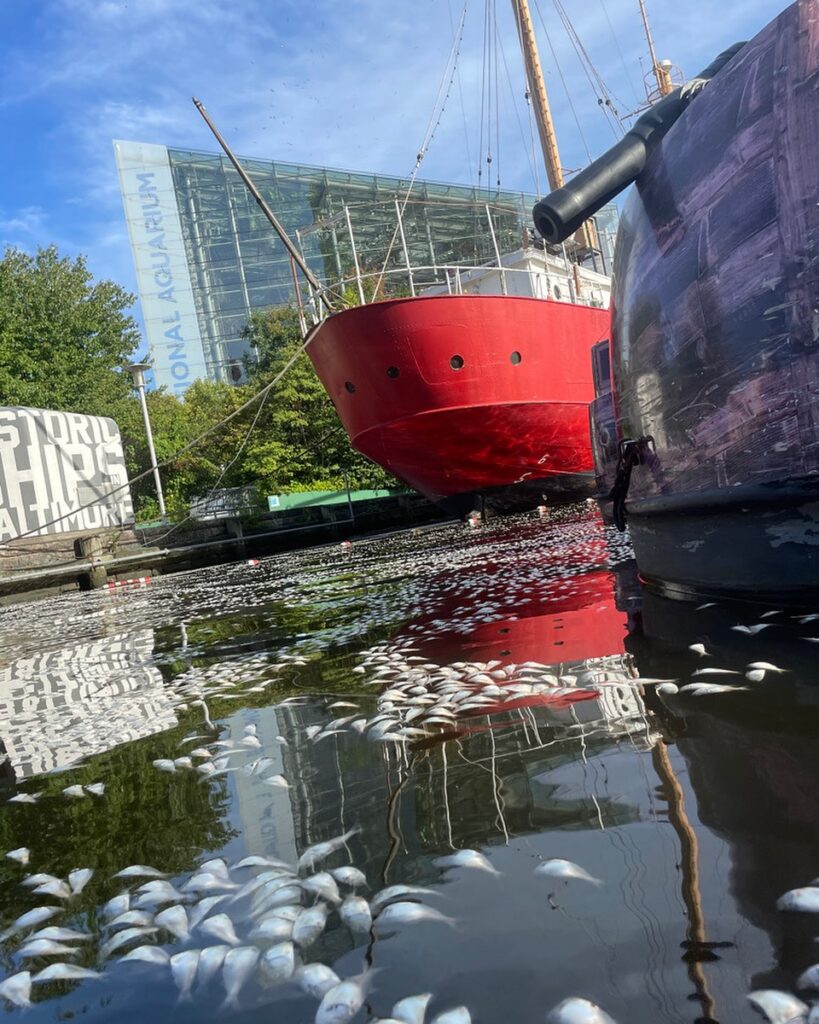It was a dramatic sight last week: tens of thousands of dead fish floating along Baltimore’s Inner Harbor promenade and an unnatural-looking light green tint to the water.
Predictably, snarky social media comments poured in, blaming the mass fish kill on Baltimore’s pollution problems and scoffing at the city recent celebrating a “swimmable” harbor.
Local leaders insist that weather conditions prompted a naturally-occurring algal bloom, which is really to blame for the fish kill. So which is it? A sign of ongoing pollution, or bad luck from Mother Nature?
Water cleanup managers with Mr. Trash Wheel (@mrtrashwheel) posted a video on Instagram showing wall-to-wall dead fish. The video said last week’s cool mornings triggered a pistachio tide, named for the light-green water that was visible in the harbor at the time of the fish kill.
Pistachio tides happen when the harbor’s surface cools quickly, so the surface water becomes dense and sinks to the bottom. The less-dense water from the bottom, in turn, churns up sulfur bacteria that causes dissolved oxygen to drop and aquatic animals to struggle to breathe in what’s known as a “dead zone”. The graph below shows the drastic drop in dissolved oxygen leading up to the fish kill last Wednesday:
The sad result was 24,000 dead fish, mostly juvenile menhaden, floating to the surface in one day. Menhaden are forage fish that play a key role in the Chesapeake Bay food chain. They are prey for rockfish (striped bass) and bluefish along with ospreys, bald eagles and dolphins.
Waterfront Partnership Vice President Adam Lindquist said in a social media post, “Wednesday, Sept. 4, 2024, was a heartbreaking day for people like me who love our city’s marine ecosystem and spend every day working toward its restoration. This week, Baltimore’s Inner Harbor experienced one of the worst fish kill events in recent memory. Thousands of Atlantic menhaden perished.”

Menhaden are already an embattled species in Virginia, where the nation’s largest menhaden processor harvests them. The Chesapeake Bay Foundation (CBF) stresses their importance, calling the fish a “bedrock of the Bay ecosystem.” CBF Maryland Staff Scientist Gussie Maguire said in a statement, “Right now, the Bay’s menhaden are pinched between industrial fishing and dead zones.”
CBF agrees with Waterfront Partnership that the Baltimore Harbor’s dead zone was fueled by seasonal temperature changes, but they feel it deserves a closer look.
The Bay Foundation say that pistachio tides like this have been happening for years when days are warm and nights are cold, but they call the size of this fish kill “alarming”. A similar algal bloom in August killed only about 1,700 fish, just seven percent of the size of this one.
National Aquarium Curator Jack Cover agrees it was the worst fish kill he has seen in the Inner Harbor, but says, “That is more due to timing rather than a continued degradation of water quality.” He says the drastic fish kill came from a “perfect storm” of conditions, a brief population explosion of the pistachio bacteria.
Once the bacterial bloom runs its course, Cover explains, dissolved oxygen levels rise back to fish supporting levels. Cover, who closely monitors the harbor waters, says that since last week’s event, no more dead fish have been seen and large schools of live menhaden have been observed.
Still, Maguire says, algae thrive on nutrient-rich stormwater runoff. As Maryland falls short on stormwater remediation goals, it risks more fish kills in the future.
Lindquist of Waterfront Partnership acknowledges that reducing stormwater runoff, repairing sewer pipes and restoring the marine ecosystem would make Baltimore Harbor more resilient to pistachio tides. “The unfortunate truth is that pistachio tides are a fact of life in the Inner Harbor,” he says.
To read Lindquist’s full explanation of pistachio tide and this fish kill, click here.





